Kaslo & Slocan Railway pass sells for $834
- Greg Nesteroff

- Sep 30
- 6 min read
Updated: Oct 1
Some amazing and incredibly rare Kootenay railway passes have sold on eBay in recent weeks for eye-popping prices. All come from the same seller in Quebec.
The one that fetched the highest price, seen below, was from the Kaslo and Slocan Railway, and made out in 1897 to W.H. Hurlburt, general passenger agent of the Oregon Railway and Navigation Co. It sold for $598.88 US, which is $834 Cdn.
This narrow-gauge railway, initially a subsidiary of the Great Northern, operated between Kaslo and Sandon from 1895-1910, whereupon a forest fire destroyed much of its infrastructure.
A local consortium bought the company and resumed operations in 1911-12, soon selling it to the Canadian Pacific Railway. The line remained in use until 1955, when Carpenter Creek went on a rampage, causing heavy damage. The K&S’s story is superbly told in Robert Turner and David Wilkie’s book, The Skyline Limited.
I’ve only ever seen one other K&S pass for sale, depicted below. It appeared on the Holabird Western Americana auction site in May 2021 and sold for $1,200 US plus a buyer’s premium of $300, the combined equivalent of just under $2,100 Cdn today.

A Columbia and Kootenay Steam Navigation Co. pass from 1896 sold this month for $444 US, which is $618 Cdn. What makes it so remarkable is that it was made out to William C. Van Horne, the president of the Canadian Pacific Railway, and signed by James W. Troup, who supervised the construction of many local sternwheelers.
The CKSN was founded in 1890 by J. Fred Hume, William Cowan, and Capt. Robert Sanderson to serve the Columbia River between Revelstoke and Northport. They soon added boats on Kootenay Lake and the Kootenay River, which operated as far south as Bonners Ferry.
Van Horne apparently liked riding the CKSN’s boats so much that he bought the company. The CPR acquired the CKSN in February 1897 and continued to expand the fleet.
An 1894 CKSN pass, seen below, sold in December 2008 for $113.61 US. Like the K&S pass at the top of the page, it was also made out to W.H. Hurlburt, although he was then an agent for the Union Pacific.
An even earlier CKSN pass from 1892, seen below, made out to D. Hanifer, sold for $36.33 US in January 2003, a ridiculously low price by today's standards.
A Kootenay Railway and Navigation Co. pass from 1901, made out to bridge engineer A.D. Page, sold this month for $147.50 US, which is $205 Cdn.
This company was created in 1899 to acquire the Great Northern Railway’s assets in the Kootenays, namely the Kaslo and Slocan, Bedlington and Nelson, Kootenay Valley Railway, as well as the International Navigation and Trading Co. While the company built the much-admired SS Kaslo, in general things did not go well. The company was liquidated in 1911.
A Spokane Falls and Northern Railway pass from 1901, made out to H.A. Jackson, general freight and passenger agent, sold this month for the relative bargain of $97 US, which is $135 Cdn.
The pass also bears the names of two sister lines, the Nelson and Fort Sheppard and the Red Mountain Railway. All three were financed by Daniel Chase Corbin. The SF&N was built from Spokane to Colville starting in 1889 and reached Northport in 1892.
When the SF&N crossed the border, its initials reversed to become the N&FS, the Nelson and Fort Sheppard, built in 1893. It crossed the Pend d’Oreille River on what is now BC’s oldest bridge in situ. The N&FS was acquired by the Northern Pacific in 1898 and the Great Northern in 1899, which became part of Burlington Northern in 1970. The line was abandoned between Salmo and Troup Junction in 1997, but it has continued to operate between Fruitvale and the border under several owners.
The Red Mountain Railway connected Rossland and Northport and operated from 1896 to 1922.
A Spokane Falls & Northern pass from 1899, seen below, made out to Thomas Fowler, president of the New York, Ontario, and Western Railway, sold for $71 US in June 2009.
A Nelson & Fort Sheppard pass from 1895, seen below, made out to A.J. Borie, assistant superintendent of the Oregon Railroad and Navigation Co., sold for $90.99 US in February 2006.
A sample Spokane and British Columbia Railway pass from 1917 sold this month for an even bigger bargain of $54 US, which is $75 Cdn.

This railway connected Republic, Grand Forks, and Lynch Creek up the North Fork, once the site of mining activity. But the railway had a much more colourful nickname: the Hot Air Line. As Wikipedia explains, this was “due to the shaky nature of the company’s financing and the grandiose nature of its publicity.”
The S&BC was incorporated in 1900 as the Republic and Kettle Valley Railway, bought in 1901 but the Republic and Grand Forks Railway, reorganized as the Spokane and British Columbia Railway in 1905 and operated through 1919, whereupon the line was abandoned. The company continued to exist on paper until 1925.
•
Not railway-related, but another really interesting item that sold recently on eBay was an envelope from the Sheep Creek Hotel, postmarked 1911 and sent by E.H. Ericksen of Nelson to Otto Paadl [?] of Stockholm. It fetched $146.49 Cdn.


Sheep Creek was a mining camp near Salmo that boomed twice. Its first incarnation lasted from about 1908-17. The hotel had several owner/operators in its short life, beginning with Conrad (Con) Robinson, who applied for a liquor license in December 1908, giving the hotel’s location as Queen Road.
In February 1910, Robinson sold the hotel to Henry Albert Matthews and wife of Nelson, but by June, Archie Bremner was the proprietor. Bremner was the best-remembered person associated with the hotel, to the extent that any of them are remembered at all. Bremner was a contractor from Renfrew, Ont., who came to Vancouver in 1892, then lived successively in Kamloops, Rossland, Nelson, Ymir, and Sheep Creek.
In 1909, when he was 37, Bremner married Hilma Ingleborn Swanson, a native of Gottenberg, Sweden. One of the witnesses at their wedding was Georgia Patrick, a sister to hockey legends Frank and Lester Patrick, who then lived in Nelson.
In August 1910, the Nelson Daily News reported that Bremner had recently served 46 men for lunch one day and provided 36 men with supper. Bremner applied for a liquor license but it was denied “as not in the public interest.” He let the booze flow anyway.
A man named J.E. Walker came into the bar and Bremner served him whiskey from a ginger ale bottle. Turned out Walker was actually a police agent. Bremner was charged with violating the licensing act and, following a trial, fined $300 plus costs or in default, nine months in jail. I assume he paid the fine.

(Greg Nesteroff collection)
With or without alcohol, in May 1911, Bremner announced business was so good that he would build an addition to the hotel to double its accommodation. He had been forced to improvise of late — and here I learned a new word, or at least a new definition. Bremner said he was “compelled to give people shake-downs in prospectors’ shacks and similar places. For instance, I fixed up six men with shake-downs in Jimmie Ryan’s shack the other night.” A shake-down (or shakedown) in this context means “a makeshift bed.”
I don’t know if the addition was built. By August 1911, one George Owen was seeking a license for the hotel, but the business appears to have reverted to Bremner before long. The hotel was last mentioned in the Daily News of May 2, 1912, when it hosted a ladies whist party, although Bremner was still listed as the proprietor in civic directories through 1920.
I have no idea how long the building stood. Was it still there when Sheep Creek began its second boom in 1928? When Archie Bremner died in Salmo in 1952, age 81, his obituary said nothing about the hotel, remarking instead on his career as a government road foreman from 1917-47.
Sheep Creek also had a halfway house, operated in 1910-11 by a Michael Crilly, which stood on Lot 10019, “on the Sheep Creek wagon road, about one mile south of the Queen mine.”
Plus a guy named R.F. Gerrells announced plans in May 1911 to build a $10,000, three-storey hotel at Sheep Creek, to be designed by Alex Carrie, Nelson’s pre-eminent architect. Work apparently began in July, but the hotel was never completed, which doesn’t surprise me, since Gerrells was a con artist. His full story is crazy and one day I’ll get around to writing it.











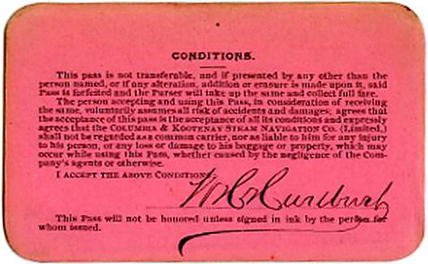
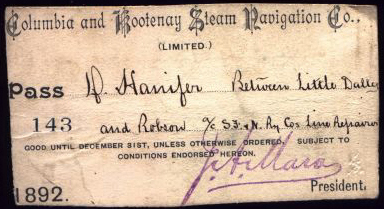
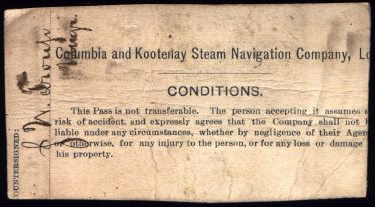













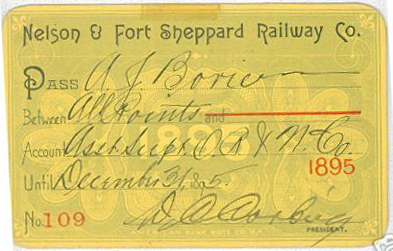
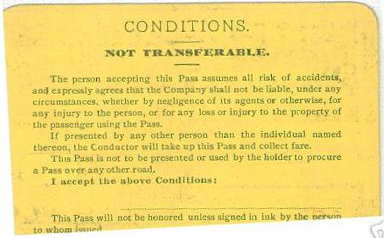



Wonderful post - thank you for all this info!
Wonderful post - thank you for all this info!
I have read the expression "shake-down" as referring to a bed before - I'm trying to remember where. Barry Broadfoot perhaps, or James Gray? For some reason a straw-tick comes to mind..
I have the CKSN pass a year earlier made out to Van Horne and signed by Troup...It has the drawing of the SS Columbia in background....think I paid $250 CDN from Albert Tanner back in early 2000s...You can see photo of it in Minto book P 13
Those passes are very interesting memorabilia. I wonder who the seller in Quebec is, and what else they might have!
Very informative and it sure takes one back, and opens another glimpse into the past!